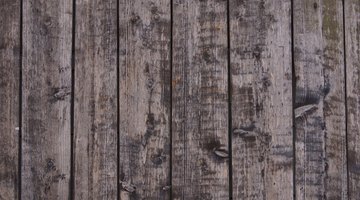What Makes Weathered Wood Turn Gray?
When wood is exposed to the elements, the weathering turns the wood a silvery, gray patina. Weathered wood is often a sought-after finish for crafting projects such as barn-wood picture frames or to accent your home in a rustic manner.

Weathering helps the wood look antique, as if the wood is much older than it actually is. Aside from graying, wood may also develop dark rings or spots, also caused by weather.
UV Light
Weathered wood turns gray from the effects of ultraviolet light rays from the sun. When sunlight hits the wood, the UV rays slowly degrade the surface and cellulose fibers in the wood. To prevent the graying process, keep wood out of direct sunlight. While preventing the sun from reaching outdoor wood, such as the wood on a sundeck or privacy fence, is unreasonable, you can use curtains or window shades or blinds to prevent sunlight from reaching wood inside the home.
Fungus and Mildew
The development of fungus and mildew, a process brought on and quickened by rain and constant dampening, can cause the gray patina in weathered wood. After the UV light begins to fade the color, mildew and fungus cause blotchy, uneven coloration. While the weathering effects aren't detrimental and some homeowners actually like the look, exposure to moisture can cause decay. The water may also rust any iron nails or screws used in the wood, leaving black and brown discoloration near them.
Considerations
As long as the wood is in good condition, normal weathering doesn't decay the wood; the effects slow down drastically after initial weathering and graying. Healthy weathered wood only decays about .25 inch every 100 years, so you don't have to worry about it unless you don't like the appearance. While the wood will not suffer too much decay due to weathering, it may crack, warp and roughen. Take caution when you notice warping, as it may pull up or loosen nails and other fastenings.
Prevention
If the weathered natural look doesn't work for you, you can take a few steps to prevent the graying process from happening. Use a stain designed specifically to prevent discoloration and weathering. Alternately, have the wood treated with a water-repelling preservative to keep moisture from seeping into the wood. Painting also works well, although you lose the natural wood look. For painting, apply an oil-based primer, then two coats of alkyd-, oil- or latex-based paint. Before applying any treatment to the wood, wash it thoroughly to remove all dirt and debris from the surface. In addition, before painting, sealing or priming, sand the wood lightly using either 80- or 100-grit sandpaper.
References
- Basic Carpentry; U.S. Army Corps of Engineers, REA Staff
- Wood Frame House Construction; L.O. Anderson
Writer Bio
Matt Koble has been writing professionally since 2008. He has been published on websites such as DoItYourself. Koble mostly writes about technology, electronics and computer topics.
Photo Credits
- Hemera Technologies/AbleStock.com/Getty Images
- Hemera Technologies/AbleStock.com/Getty Images
More Articles



